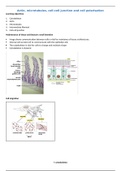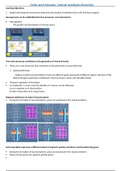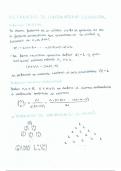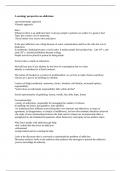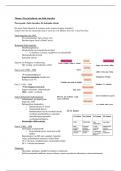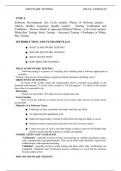WEEK 2
Lesson Video #1 - Introduction to Job Analysis
Difference Between Job and Position:
Job - collection of related tasks, duties, responsibilities that are grouped together for the
purpose of accomplishing work within an organization. (many people can work in a job, there
can be many positions)
Position - specific instance of a job held by a single person (one position, one person works)
What is a Job Analysis?
- Systematic process of collecting detailed information pertaining to a job
- Includes tasks, duties, responsibilities, and human attributes
- Typically carried out on a continuous basis - info pertaining to a job is continuously
updated by the hr department
Why is Job Analysis Important?
- Used to perform many activities that the HR department oversees.
- Key areas impacted by information collected through job analysis:
- Recruitment and selection → process by which we attract screen and select
suitable candidates (refers to the hiring process)
- Training and development → teach both existing and new employees the key
knowledge and skills they need to perform their job effectively. Through job
analysis, HR personnel identify the tasks that are associated with each job.
Informs the training of new employees to make sure they can confidently step
into their new roles. Training programs can be developed to ensure safe training
and course correction
- Performance Management → refers to a system which ensures that employee
outputs contribute to organizational success. Key part of performance
management is performance evaluation - an assessment of how effective
employees are in completing their jobs.
- Compensation management → informs how much employees get paid as part
of their salary, which employees get bonuses, and whether additional financial
incentives are provided to specific employees.
Lesson Video #2 - Steps in a Job Analysis
Step 1 - Review Background Information
3 relevant sources of information:
- Previous Job Analysis Data → job analysis is ongoing, should be some records available
from previous job analysis
- Digital Databases → the most comprehensive database is the National Occupational
Classification (NOC). Contains standardized descriptions of over 30,000 jobs. Outlines
employment requirements that the person should have including relevant educational
requirements, certifications and licenses. This database is updated every 5 years
- Organizational Charts - visual diagrams that are created by organizations. Show relative
ranks of jobs and indicate relationships among the jobs (i.e. chain of command).
, - Three Main Structures in Organizational Charts
- Bureaucratic
- Numerous levels of management
- Narrowly defined jobs
- Common in larger organizations
- Clear lines of communication (major benefit)
- Separation between units
- Flat
- Few (if) any levels of management
- More broadly defined jobs - each employee is responsible for
large number of tasks
- often seen in smaller organizations
- Highly structured and collaborative
- Matrix
- Two lines of accountability
- Organized and communicative
- Conflicts are possible
DIAGRAMS FOR ORGANIZATIONAL CHARTS SHOWN BELOW
,
, Step 2 - Choose Sources of Job Info
Subject Matter Exports (SME’s) → there are 3 types in which personnel can obtain job
relevant data:
Incumbents
- Individual currently holding position
- most detail knowledge about the job
- provide inaccurate or exaggerated information to try to make their role in the
organization as important as possible - leads to potentially false data
Supervisors
- Has charge over a workplace
- Know about the relevant importance about the job, less knowledgeable about day-to-day
events, they only speak about the tasks but lack the details that the incumbents provide
Job Analyst
- Lacks familiarity with information and cannot provide a fully accurate picture of the job
and of its place in the organizational structure
- Can provide objective assessment - they bring an objective perspective to the
organization
Step 3 - Gather Job Info
Numerous methods available in which this can be done, some include:
Direct Observation
- Observe incumbents in the performance of their duties
- Record nature, frequency, duration, outputs, equipment
- Ideal for jobs involving observable physical activities - this is a limitation
- Incumbents may change behaviour when observed - this is a limitation, this can lead to
incorrect or misleading job data (i.e. take on tasks that they usually don't do)
Interview
- Can be conducted alone or in groups
- Supervisors should not be present during incumbent interviews- mixing SME’s
categories can result in dishonest responses
- SMEs may not provide accurate information to protect own interest (exaggerate, omit)
^Interviews could result in inaccurate information being shown
Questionnaires
- Completed by SMEs
- Can include open ended or close ended questions
- Can use existing questionnaires or develop their own
Step 4 - Develop Key Components
Collected information is used to develop these two documents:
Job description (what a job entails)
- Tasks
- Duties
- Responsibilities
^ these three components are referred to as the TDRs
Lesson Video #1 - Introduction to Job Analysis
Difference Between Job and Position:
Job - collection of related tasks, duties, responsibilities that are grouped together for the
purpose of accomplishing work within an organization. (many people can work in a job, there
can be many positions)
Position - specific instance of a job held by a single person (one position, one person works)
What is a Job Analysis?
- Systematic process of collecting detailed information pertaining to a job
- Includes tasks, duties, responsibilities, and human attributes
- Typically carried out on a continuous basis - info pertaining to a job is continuously
updated by the hr department
Why is Job Analysis Important?
- Used to perform many activities that the HR department oversees.
- Key areas impacted by information collected through job analysis:
- Recruitment and selection → process by which we attract screen and select
suitable candidates (refers to the hiring process)
- Training and development → teach both existing and new employees the key
knowledge and skills they need to perform their job effectively. Through job
analysis, HR personnel identify the tasks that are associated with each job.
Informs the training of new employees to make sure they can confidently step
into their new roles. Training programs can be developed to ensure safe training
and course correction
- Performance Management → refers to a system which ensures that employee
outputs contribute to organizational success. Key part of performance
management is performance evaluation - an assessment of how effective
employees are in completing their jobs.
- Compensation management → informs how much employees get paid as part
of their salary, which employees get bonuses, and whether additional financial
incentives are provided to specific employees.
Lesson Video #2 - Steps in a Job Analysis
Step 1 - Review Background Information
3 relevant sources of information:
- Previous Job Analysis Data → job analysis is ongoing, should be some records available
from previous job analysis
- Digital Databases → the most comprehensive database is the National Occupational
Classification (NOC). Contains standardized descriptions of over 30,000 jobs. Outlines
employment requirements that the person should have including relevant educational
requirements, certifications and licenses. This database is updated every 5 years
- Organizational Charts - visual diagrams that are created by organizations. Show relative
ranks of jobs and indicate relationships among the jobs (i.e. chain of command).
, - Three Main Structures in Organizational Charts
- Bureaucratic
- Numerous levels of management
- Narrowly defined jobs
- Common in larger organizations
- Clear lines of communication (major benefit)
- Separation between units
- Flat
- Few (if) any levels of management
- More broadly defined jobs - each employee is responsible for
large number of tasks
- often seen in smaller organizations
- Highly structured and collaborative
- Matrix
- Two lines of accountability
- Organized and communicative
- Conflicts are possible
DIAGRAMS FOR ORGANIZATIONAL CHARTS SHOWN BELOW
,
, Step 2 - Choose Sources of Job Info
Subject Matter Exports (SME’s) → there are 3 types in which personnel can obtain job
relevant data:
Incumbents
- Individual currently holding position
- most detail knowledge about the job
- provide inaccurate or exaggerated information to try to make their role in the
organization as important as possible - leads to potentially false data
Supervisors
- Has charge over a workplace
- Know about the relevant importance about the job, less knowledgeable about day-to-day
events, they only speak about the tasks but lack the details that the incumbents provide
Job Analyst
- Lacks familiarity with information and cannot provide a fully accurate picture of the job
and of its place in the organizational structure
- Can provide objective assessment - they bring an objective perspective to the
organization
Step 3 - Gather Job Info
Numerous methods available in which this can be done, some include:
Direct Observation
- Observe incumbents in the performance of their duties
- Record nature, frequency, duration, outputs, equipment
- Ideal for jobs involving observable physical activities - this is a limitation
- Incumbents may change behaviour when observed - this is a limitation, this can lead to
incorrect or misleading job data (i.e. take on tasks that they usually don't do)
Interview
- Can be conducted alone or in groups
- Supervisors should not be present during incumbent interviews- mixing SME’s
categories can result in dishonest responses
- SMEs may not provide accurate information to protect own interest (exaggerate, omit)
^Interviews could result in inaccurate information being shown
Questionnaires
- Completed by SMEs
- Can include open ended or close ended questions
- Can use existing questionnaires or develop their own
Step 4 - Develop Key Components
Collected information is used to develop these two documents:
Job description (what a job entails)
- Tasks
- Duties
- Responsibilities
^ these three components are referred to as the TDRs



